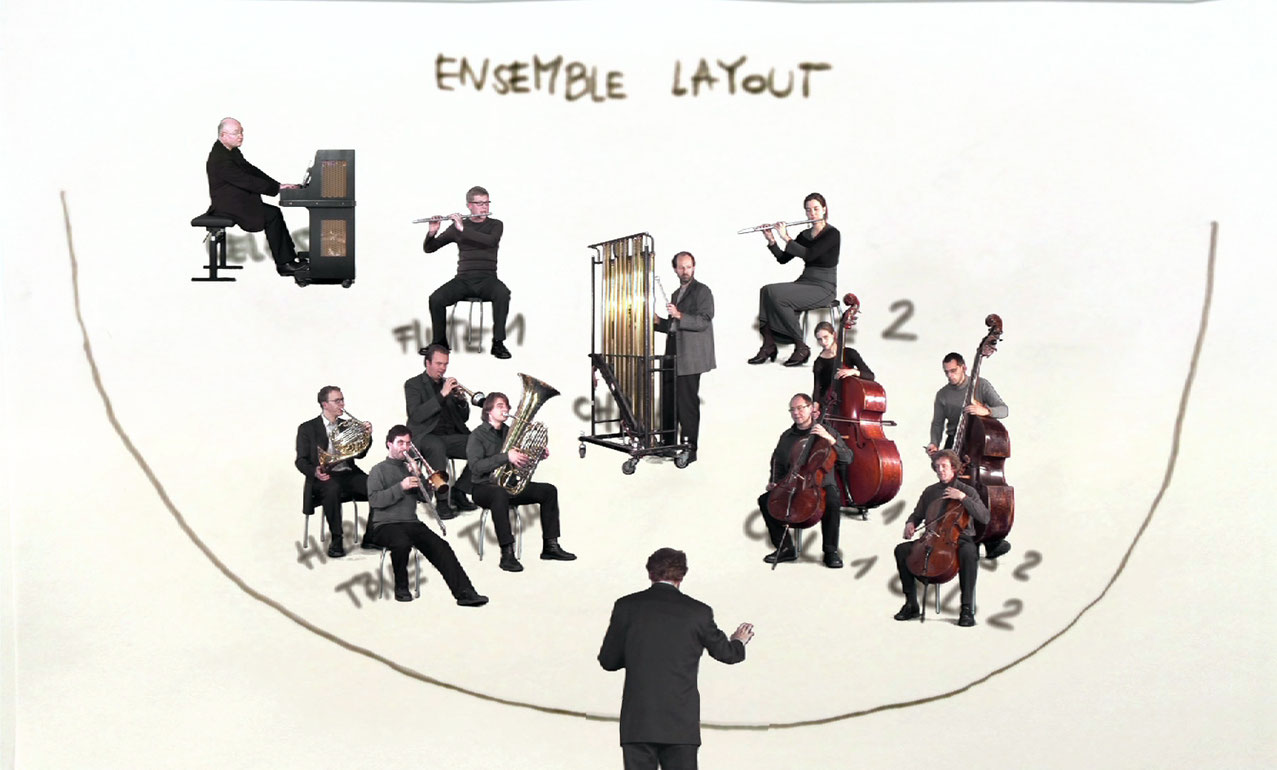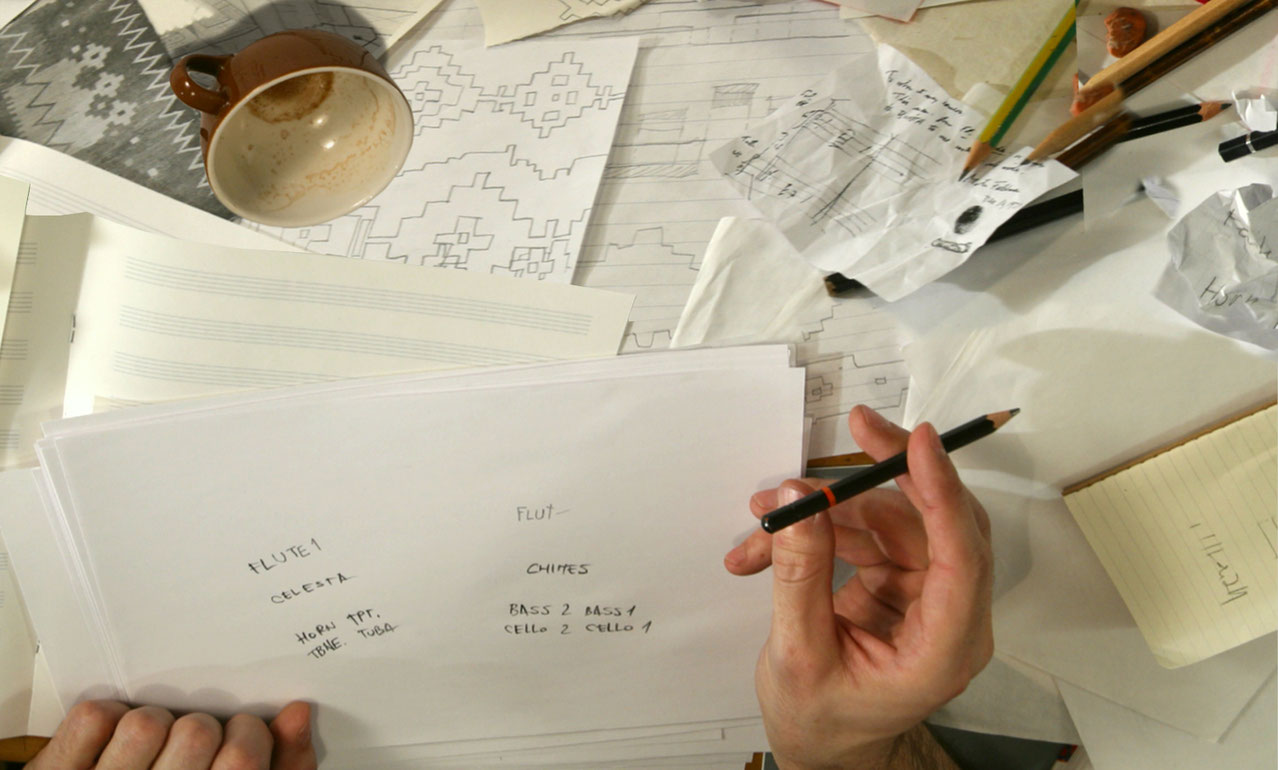Seems to Be
Based on Morton Feldman´s "Madame Press Died Last Week at Ninety", Seems to be plays with the levels of optic and aural perception, with the deception of eyes and ears as well as the tension between two-dimensional reproduction and three-dimensional spatial recreation.
(production note)
Accompanied by murmuring, the sound of scribbling and hummed snatches of music, the camera sweeps over a collection of materials on a desktop, seemingly reflecting a creative frenzy. Musical notes and memoranda, pads and pencils, patterns of various kinds, mixed with slips of paper, half-full Martini glasses, ashtrays, death´s heads - then the picture swings around (the coffee cup along with it!) and an ensemble arranged according to musical instrument has been committed to paper. Constant movement, metamorphosis, variation and pleasant uncertainty: a concert hall? A movie theater?
The picture´s square remains, becoming in the course of the switch a bright square within the picture: a projection screen with an ensemble in the form of a projection screen in front of the ensemble, which is suddenly no more than a shadow of itself. Madame Press is dead. The imagination lives on. At least that seems to be the case.
(Christoph Huber)
A meditation on the certainties of being and perceptual illusions, a circling search in time and space, and at the same time a trompe l´oeil; the spatial dimensions of Morton Feldman´s steady, apparently timeless music are taken literally in the film: The sketched arrangement of a musical ensemble about to perform Feldman´s composition fills with "real" musicians caught in the paper´s two-dimensionality, only to move to the spatiality of the Vienna Konzerthaus. But what is real here, what is a visual fake? Seems to be dances on this platform of ambivalences, juxtaposing the metaphysics of a solid existential foundation and the agnostic skepticism of an abandonment of being marked by a visual chimera.
Godless Feldman, merciless abyss! What we see is looking back at us.
(Thomas Miessgang)
Translation: Steve Wilder
Morton Feldman’s “Madame Press Died Last Week at 90” is more sober and constricted than Mr. Furrer’s score. It revolves mostly around two repeated chords, and its instrumental textures are comparatively steady. In Schein Sein (“Seems to Be”), Ms. Minck again shows the players as they drop in and out of the score, but she also pulls back to show the musicians on the screen, the screen on a stage and the stage in a hall with an audience. It was an appealing if self-conscious solution, if making the films a matched set was the goal.
(Allan Kozinn, New York Times)
In Schein Sein (“Seems to Be”) Ms. Minck pans across a desk cluttered with significant Feldman cues — a Mondrian painting, a rug pattern, the voice of John Cage — before playing perceptional games to the tune of Mr. Feldman’s “Madame Press Died Last Week at 90.”
(Steve Smith, New York Times)
"Être paraître" / texte français
Sur un fond sonore de chuchotements, de grattements et de bribes de rumeurs bourdonnantes, la caméra survole une multitude dobjets que la passion créatrice semble avoir accumulés sur un bureau. Notes et mémentos, cahiers et crayons, échantillons de toutes sortes éparpillés parmi les feuilles volantes, verres de Martini entamés, cendriers débordants, têtes de mort et puis, sur une subite inversion de plan (incluant une tasse de café !), une feuille représentant la distribution des instruments dans un ensemble musical. Mouvement incessant, métamorphose, variations et bienfaisante incertitude : une salle de concert, un cinéma ?
Le rectangle de limage sestompe pour finir par nêtre plus, tout au long du travelling, quun rectangle lumineux dans limage : lécran, avec son ensemble, se fait écran devant lensemble, et ce dernier nest soudain plus que lombre de lui-même. Madame Press est morte. Limagination est bien vivante. Cest tout au moins ce quon pourrait croire. (Christoph Huber)
Méditation sur la certitude de lexistence et les illusions perceptives, mouvement de quête circulaire à travers lespace et le temps tout autant que trompe-lil, ce film prend au mot dans sa dimension spatiale la musique de Morton Feldman, dédramatisée et apparemment placée hors du temps : lesquisse représentant lensemble qui sapprête à interpréter la composition de Feldman semplit maintenant de musiciens « réels », tout dabord prisonniers de la bidimensionnalité du papier pour être par la suite basculés dans la spatialité du Konzerthaus de Vienne. Mais quelle est ici la part de vérité, la part de falsification visuelle ? Être paraître joue sur cette scène des ambivalences en opposant à la métaphysique dune solide assise existentielle le scepticisme agnostique dun abandon de lêtre marqué au coin de la chimère visuelle.
Feldman le mécréant, abîme sans pitié ! Ce que nous voyons porte le regard sur nous. (Thomas Miessgang)
Traduction: Claude Manach
Schein Sein
2008
Austria, Luxembourg
8 min 10 sec


